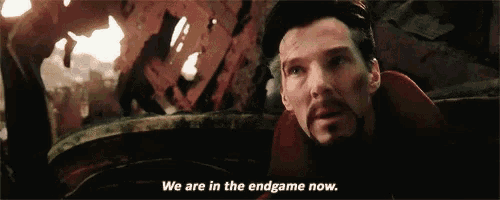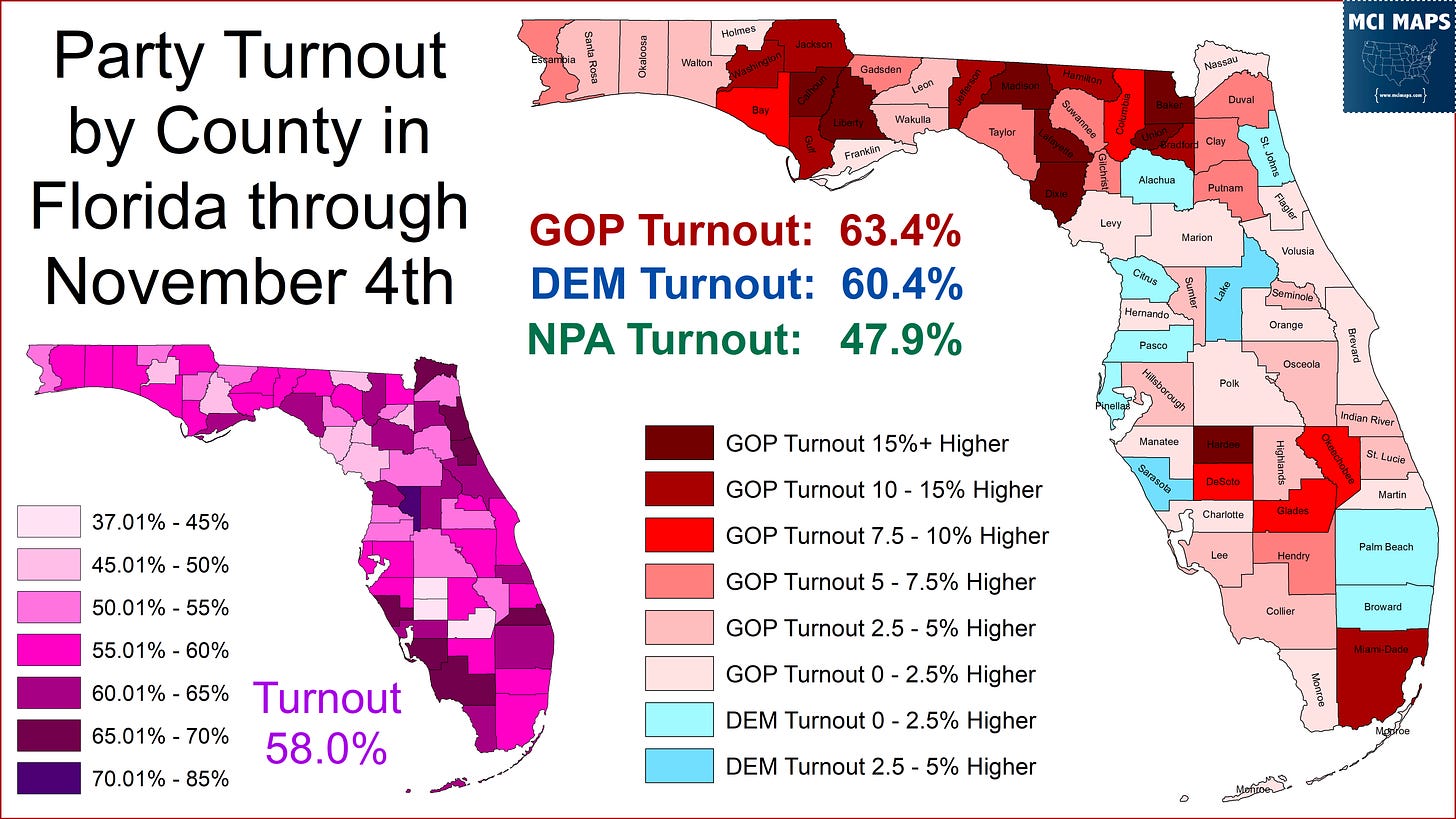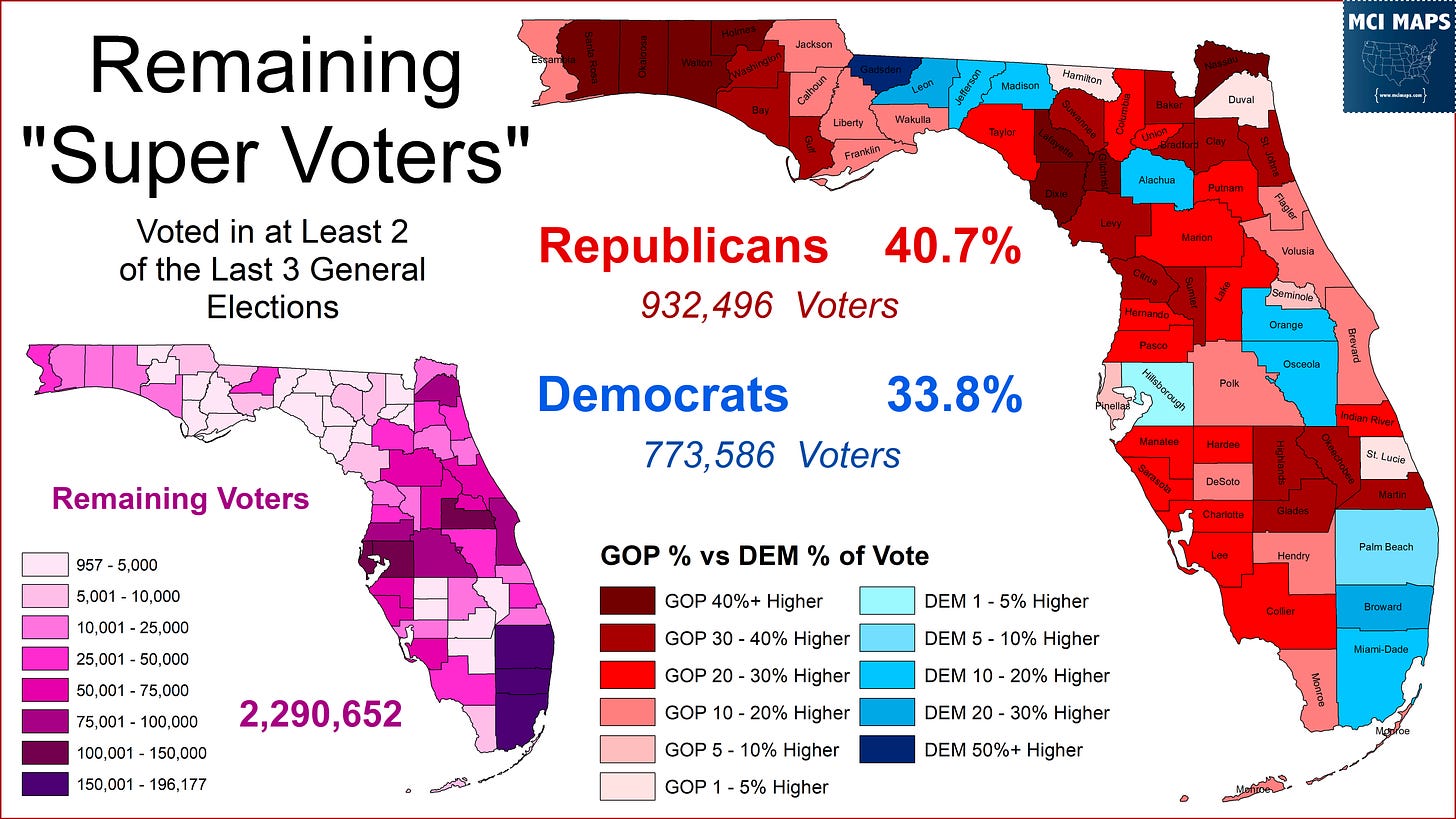Issue #211: How Red or Blue will Election Day be in Florida
Lets look at who has yet to cast a ballot
Well folks, here we are. The polls have opened in Florida. It is election day.
I wanted to offer up a final snapshot of where voting stands in Florida. I recently wrapped up articles looking at the assorted battles for State House and State Senate. You can read both in those respective links.
The Votes Cast So Far
So where do things stand in Florida? We are just over 8,000,000 ballots cast, with Republicans holding a 10% lead. They have largely maintained that 10% lead for the last 9 or so days.
This lead is thanks to strong in-person early vote figures. Democrats maintained a 200,000 or so vote lead with mail ballots. However, Republicans lead in in-person voting by 1,000,000. This gives the Republicans an 800,000 person lead.
Republicans started the first week of early voting with a massive lead over Democrats, often around 2-1. The first weekend became less red, and as the last week went on, NPA voters made their presence more felt. Then, on the final Sunday of early voting, Democrats won the day.
This Sunday lead fit with previous years. The final Sunday is “Souls to the Polls” - a day where Black voters often go and early vote after church. Many counties see big events to correspond with this, and even in communities with no organized event, it has become a tradition. Many redder counties also do not have early voting this day, but major urban centers with large Black populations do.
Sunday aside, however, Republicans maintain a firm lead in votes cast.
Turnout Status
I’ve discussed this in previous issues, but the wide gap in vote cast is not due to poor Democratic turnout. Right now the Republicans only hold a 3% lead in vote cast. This lead is widest in rural counties and also Miami-Dade. I’ll get to Dade in a bit. Otherwise, many counties see narrow Democratic or Republican turnout leads. Again this is not a share of the vote cast map - it is which side is getting a higher % of their voters out.
The more detailed breakdown of turnout by party and race can be seen below.
The big issue for Florida Democrats is that the registration gap is so high. I wrote about this over the weekend. Currently Republicans have an 8% lead in active registered voters - right around 1,000,000 people.
As a result of this wide gap in registration, a 3% turnout difference translates into a 10% vote cast lead. Below you can see how registration and votes cast compared for each election in Florida since 2012. Turnout right now is historically good, but the registration gap is unprecedented.
Despite Democrats having much stronger turnout than in 2022, the vote-cast share is almost the same (12% vs 10%). That is because over just two years the registration gap widened greatly. I highly recommend you read my registration issue for more details on why this happened. I confirm some notions and dispel some other myths. So give that a read.
Now its entirely likely that the 3% turnout gap will grow by the end of today Election Day will lean red, though I’ll get into the debate over HOW red in a moment.
Also, as the racial data above showed, Black and Hispanic turnout still lag white turnout. Granted this is always the historic case. In 2020, white turnout was 79%, Black turnout was 70%, and Hispanic turnout was 71%. Election Day is often the most common day for Black voters to cast ballots other than Souls to the Polls - with few using vote-by-mail as a common method. We should see turnout for all racial groups go up today - we will just see if that turnout gap narrows, expands, or remains the same.
Speaking of racial turnout, I have also tracked turnout by race and party. Here we see one glaring issue for Democrats, and that is a 10% turnout gap among Hispanic voters. Hispanic Republicans are already at 62% while Hispanic Democrats lag at 52%.
Turnout among white voters leans Democratic. By the end of the election it will surely lean Republican. However, this is the demographic where, even in 2022, the DEM vs GOP turnout remained closest. Of course, white voters in Florida are heavily Republican.
How Election Day might look
Back in 2020, Election Day was ruby-red. Of course this was the COVID era, where Democrats racked up massive vote-by-mail numbers. The polarization of COVID mitigation and Trump’s attacks on mail-in voting led what is seen below.
I discussed this much more in my 2020 Deep Dive into Florida.
So how might Election Day look this time? To get a feeling for that, I looked at who has not voted yet. In 2020, I and many others knew election day would be very red because so many more Republicans had yet to vote. Democrats had cannibalized their vote already.
For this go around, I wanted to see who has not voted yet and also break it down by their voting propensity. Below you can see a series of tables that break down voters by party and their voting history. The bottom right table shows who has note voted yet.
If everyone in the “remaining” table voted, the Republicans would be able to net another 260,000 voters. The best news for Republicans is they have a 180,000 voters lead with people who voted in 3 of the last 3 general elections. Democrats lead with 2 of 3s, but only by 20,000. Those 0 of 3s include many newer registrants, so don’t count them out either - plenty will show up.
So based on this, I know election day will be red. However, how red will depend on how well Democrats can keep pace with the lower-propensity voter groups. I can assume most 3 of 3s will show. Democrats will face real problems, and get a ruby-red election day, if the turnout gap among those below is very high. Democrats are not DESTINED for a ruby-red election day, like they were in 2020. However, the Republicans clearly have more voters - which again reflects that registration lead.
How today shake’s out is really up in the air here. It will likely vary wildly by county. I pulled the 2 of 3 and 3 of 3 voters from the table above and mapped them out by county. As the map below shows, several more Democratic “super voters” than Republicans. In several of these, this could be critical for different legislative and local elections.
To continue on this point, Miami-Dade has been a major source of heartburn so far in early voting. The turnout gap is bad, even worse among Hispanic voters. So is Dade destined to go red? Well, it depends on the remaining vote - which leans Democratic.
Republicans will surely end the day with a more votes cast than Democrats. However, what Democrats want is a small gap, where independents can play kingmaker. Democrats can close the turnout gap they have if they get a good election day vote. Historically, pre-COVID, Miami-Dade election day often would lean blue. Is Miami-Dade reverting to that? Or will we just end with a really bad Miami-Dade turnout? We will know soon.
All this combined tells me we will have a red election day, but I am keenly watching what happens in the counties that effect the legislative races I covered in the last couple days.
Final Thoughts
I said this on Sunday - the biggest issue for Democrats having a shock win in Florida is the registration gap. Turnout is solid statewide, but that 10 point gap in votes cast, which could increase today, is alot to overcome. I expected Trump will underperform Republicans in the suburbs of Orlando, Tampa, or Jacksonville. However, he won’t face that problem with many of the conservative retirees, the rich coastal towns that only care about their tax rate, or the rural voters.
I believe Florida remains Likely Republican. Its not Tennessee, its not Utah. However, its red - thanks to its registration. However, as I have said many times, my metric for Democratic Party success is winning regional and local races this year. I said this exact thing two years ago. Florida Democrats needed to use this year to regionally rebuild, win some legislative posts, some county commission seats, and show “signs of life” - which will encourage donors and national orgs to invest in the party. Today I won’t be focused on turnout in Sarasota or Clay Counties. I’ll be watching places like Osceola, Hillsborough, Leon and of course Miami-Dade.
We will see how everything shakes out!

















How many of those registered GOPs are crossover voters? Almost 20% of us didn't vote for Trump in the primary (almost 14% for Haley, who had withdrawn by then). That's going to be important.